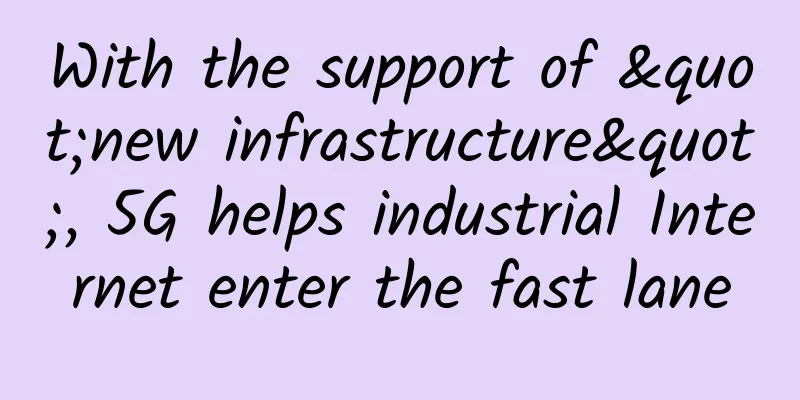With the support of "new infrastructure", 5G helps industrial Internet enter the fast lane

|
2020 is a year full of "dangers" and "opportunities". The spread of the COVID-19 pandemic has forced the global economy to slow down and even face increasing downward pressure. At the same time, in the midst of the crisis, emerging digital formats, represented by online office, online education, telemedicine, and online public services, have shown an explosive trend. In addition, the pace of new infrastructure construction (referred to as "new infrastructure") has gradually accelerated. As a basic and leading industry of the national economy, the ICT industry has played a vital role in promoting sustainable social, economic, and environmental development.
Therefore, with the support of "new infrastructure", 5G will help the development of industrial Internet enter the fast lane, bring hope for economic recovery, and promote the realization of the Sustainable Development Goals (SDGs). 5G is the optimal solution for industrial Internet needs In the face of the current global situation where uncertainty continues to increase, the industrial Internet will be the key to reshaping the vitality and resilience of the industry. The transformation of the industrial Internet will inevitably require the support of "new infrastructure" that is different from the infrastructure of the industrial era. Yang Guang, senior analyst in the field of wireless communications at Strategy Analytics, said that 5G's promotion of the development of the industrial Internet is mainly reflected in the fact that the technical characteristics of 5G can well meet the needs of the development of industrial interconnection for connection technology. "As a wireless communication technology that natively supports low latency and high reliability, 5G can well integrate the performance of low latency, high reliability and the deployment flexibility of wireless technology, becoming the optimal solution to meet the needs of the Industrial Internet." Yang Guang further stated that a considerable number of Industrial Internet applications require low latency and high reliability communication connections, such as remote control, autonomous driving, and automatic defect detection on production lines. Traditional wireless communication technologies such as 3G, 4G or Wi-Fi are difficult to meet their requirements for latency and reliability. Although wired communication technology can meet such requirements, it has weaknesses in deployment flexibility and cannot fully meet the needs of deployment flexibility in Industrial Internet applications. For example, in flexible manufacturing scenarios, the production process is often adjusted, and the deployment and installation of wired communication lines will affect the overall production efficiency. In the long run, as a new generation of global mobile communication technology standard, 5G's user base and industrial ecology will be greatly enriched, which is of great significance for expanding the scale of the industry and reducing the cost of industrial Internet development. Deep integration, building an ecosystem, and accelerating the achievement of SDG goals New infrastructure is the cornerstone of digitalization, networking, and intelligence, and has prompted the emergence of new models, new formats, and new achievements in all walks of life. Industrial Internet is one of the most important applications of new infrastructure, dedicated to promoting industrial upgrading through digital technology, becoming the most personal digital assistant for all walks of life, and promoting the deep integration of traditional industries and the Internet. So, how can the industrial Internet be deeply integrated with the real economy, and what challenges are there at present? Yang Guang said that the primary goal of the industrial Internet is to improve the production efficiency of various industries. This process still needs to be carried out by enterprises in various industries. Only enterprise users know exactly where the pain points of improving their own production efficiency are. The overall informatization level of Chinese enterprises is still behind that of developed markets, which is also the main factor affecting the development of the industrial Internet. Therefore, promoting the development of the industrial Internet should focus on improving the overall level of enterprise informatization, such as the use of technical infrastructure such as cloud computing, big data, and new generation communication technologies. These are also the core areas of "new infrastructure" and are very consistent with the policy goal of promoting high-quality economic development. "The next ten years will be a critical decade for achieving the SDG goals, and also a decade for the development and growth of the industrial Internet. The development cycles of the two coincide with each other, and the full development of the industrial Internet will be an important foundation for achieving the SDGs." Yang Guang finally said that the scope of the United Nations SDGs is very broad, involving all aspects of human production and life. This requires us not only to pay attention to network and information infrastructure, but also to the application ecology. Only by actively building an ecological system for industrial interconnection can we truly promote the realization of SDGs. |
<<: Since the advent of 5G, 4G network speed has become slower and slower?
Recommend
An overview of 10 common HTTP status codes
Overview The HTTP status code is a 3-digit code u...
Ruishu's next-generation WAF-WAAP platform has three major engines that fully upgrade application security protection
In recent years, web applications have become the...
How do IDC, CDN, and cloud service providers upgrade to IPv6?
With the rapid development of the Internet, IPv4 ...
Data roaming is cancelled. China Mobile, China Unicom and China Telecom, the three major operators, said that international roaming fees will continue to be reduced.
Starting from July 1, the three major operators o...
What role does a switch play in a network?
Switches play an important role in increasing the...
SD-WAN is about to dominate edge networks
Network transmission is like playing a team battl...
Cisco appears at the 4th National Cyber Security Publicity Week, committed to building a secure "all-intelligent network"
[51CTO.com original article] In the golden autumn...
5G and eSIM are now a must for IoT companies
Embedded Subscriber Identity Module (eSIM) techno...
6G Proposal: Entering a new stage and meeting new challenges
At the 44th meeting of the ITU-R WP5D, the ITU co...
What are the SFP and QSFP interfaces of switches?
When it comes to computer networks and data trans...
CloudCone: Los Angeles VPS from $1.80/month, Cloud Server (SC2) from $1.65/month
CloudCone hasn't had a flash sale for a long ...
The rise of the NetOps engineer
NetOps, also known as NetDevOps, is the practice ...
ZJI: 580 yuan/month 2×E5-2630L, 32G memory, 480G SSD, 10M bandwidth, Hong Kong Confederation data center
ZJI is a well-known hosting company in the WordPr...
Li Jie from CAICT: Analyzing the Development of Computing Networks from the Perspective of “Eastern Data and Western Computing”
Recently, the National Development and Reform Com...
The ultimate solution to the problem that Github cannot display images
[[379338]] Preface Not long ago, I encountered th...





![[6.18] Megalayer flash sale: Hong Kong independent server starts from 199 yuan/month, high-defense server starts from 299 yuan/month](/upload/images/67cabe62b75a5.webp)



